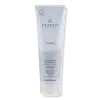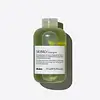What's inside
What's inside
 Key Ingredients
Key Ingredients

No key ingredients
 Benefits
Benefits

 Concerns
Concerns

 Ingredients Side-by-side
Ingredients Side-by-side

Water
Skin ConditioningSodium Lauroyl Methyl Isethionate
CleansingCocamidopropyl Betaine
CleansingSodium C14-16 Olefin Sulfonate
CleansingSodium Chloride
MaskingHedychium Coronarium Root Extract
MaskingLaminaria Digitata Extract
Skin ProtectingMacadamia Integrifolia Seed Oil
Skin ConditioningSimmondsia Chinensis Seed Oil
EmollientPersea Gratissima Oil
Skin ConditioningBeta Vulgaris Root Extract
Skin ConditioningAloe Barbadensis Extract
Skin ConditioningAnthemis Nobilis Flower Extract
MaskingAscophyllum Nodosum Extract
Skin ConditioningRosmarinus Officinalis Leaf
Skin ConditioningYeast Extract
Skin ConditioningHydrolyzed Soy Protein
HumectantLeuconostoc/Radish Root Ferment Filtrate
AntimicrobialGlycine
BufferingValine
MaskingIsoleucine
Skin ConditioningProline
Skin ConditioningThreonine
Histidine
HumectantPhenylalanine
MaskingArginine
MaskingAlanine
MaskingSerine
MaskingHyaluronic Acid
HumectantDisodium Cocoamphodiacetate
CleansingDivinyldimethicone/Dimethicone Copolymer
Glycerin
HumectantDisodium Cocoyl Glutamate
CleansingPEG-150 Distearate
EmulsifyingPropylene Glycol
HumectantQuaternium-80
Citric Acid
BufferingStyrene/Acrylates Copolymer
Sodium Glycolate
BufferingPolyquaternium-10
Xylitylglucoside
HumectantAnhydroxylitol
HumectantCoco-Glucoside
CleansingTrisodium Ethylenediamine Disuccinate
C12-13 Alketh-23
CleansingC12-13 Alketh-3
EmulsifyingXylitol
HumectantPhenoxyethanol
PreservativeBenzoic Acid
MaskingCaprylic/Capric Triglyceride
MaskingSodium PCA
HumectantSodium Lactate
BufferingSodium Hyaluronate
HumectantLactic Acid
BufferingAspartic Acid
MaskingPCA
HumectantBisamino PEG/PPG-41/3 Aminoethyl Pg-Propyl Dimethicone
PEG-12 Dimethicone
Skin ConditioningMagnesium Chloride
Magnesium Nitrate
Methylisothiazolinone
PreservativeMethylchloroisothiazolinone
PreservativeParfum
MaskingLimonene
PerfumingHexyl Cinnamal
PerfumingBenzyl Salicylate
PerfumingWater, Sodium Lauroyl Methyl Isethionate, Cocamidopropyl Betaine, Sodium C14-16 Olefin Sulfonate, Sodium Chloride, Hedychium Coronarium Root Extract, Laminaria Digitata Extract, Macadamia Integrifolia Seed Oil, Simmondsia Chinensis Seed Oil, Persea Gratissima Oil, Beta Vulgaris Root Extract, Aloe Barbadensis Extract, Anthemis Nobilis Flower Extract, Ascophyllum Nodosum Extract, Rosmarinus Officinalis Leaf, Yeast Extract, Hydrolyzed Soy Protein, Leuconostoc/Radish Root Ferment Filtrate, Glycine, Valine, Isoleucine, Proline, Threonine, Histidine, Phenylalanine, Arginine, Alanine, Serine, Hyaluronic Acid, Disodium Cocoamphodiacetate, Divinyldimethicone/Dimethicone Copolymer, Glycerin, Disodium Cocoyl Glutamate, PEG-150 Distearate, Propylene Glycol, Quaternium-80, Citric Acid, Styrene/Acrylates Copolymer, Sodium Glycolate, Polyquaternium-10, Xylitylglucoside, Anhydroxylitol, Coco-Glucoside, Trisodium Ethylenediamine Disuccinate, C12-13 Alketh-23, C12-13 Alketh-3, Xylitol, Phenoxyethanol, Benzoic Acid, Caprylic/Capric Triglyceride, Sodium PCA, Sodium Lactate, Sodium Hyaluronate, Lactic Acid, Aspartic Acid, PCA, Bisamino PEG/PPG-41/3 Aminoethyl Pg-Propyl Dimethicone, PEG-12 Dimethicone, Magnesium Chloride, Magnesium Nitrate, Methylisothiazolinone, Methylchloroisothiazolinone, Parfum, Limonene, Hexyl Cinnamal, Benzyl Salicylate
Water
Skin ConditioningSodium C14-16 Olefin Sulfonate
CleansingSodium Lauroyl Methyl Isethionate
CleansingCocamidopropyl Betaine
CleansingSodium PCA
HumectantDecyl Glucoside
CleansingDisodium Coco-Glucoside Citrate
EmulsifyingSodium Methyl 2-Sulfolaurate
CleansingLauramidopropylamine Oxide
CleansingCoco-Glucoside
CleansingGlyceryl Oleate
EmollientPanthenol
Skin ConditioningBenzyl Alcohol
PerfumingParfum
MaskingSodium Chloride
MaskingPolysorbate 20
EmulsifyingSodium Methyl Isethionate
EmulsifyingSodium Benzoate
MaskingCitric Acid
BufferingLauric Acid
CleansingDisodium 2-Sulfolaurate
CleansingMyristamidopropylamine Oxide
CleansingPolyquaternium-7
Trisodium Ethylenediamine Disuccinate
Guar Hydroxypropyltrimonium Chloride
Skin ConditioningTetrasodium Glutamate Diacetate
Sodium Laurate
CleansingCucumis Melo Fruit Extract
Skin ConditioningCI 19140
Cosmetic ColorantCI 61570
Cosmetic ColorantCI 14700
Cosmetic ColorantWater, Sodium C14-16 Olefin Sulfonate, Sodium Lauroyl Methyl Isethionate, Cocamidopropyl Betaine, Sodium PCA, Decyl Glucoside, Disodium Coco-Glucoside Citrate, Sodium Methyl 2-Sulfolaurate, Lauramidopropylamine Oxide, Coco-Glucoside, Glyceryl Oleate, Panthenol, Benzyl Alcohol, Parfum, Sodium Chloride, Polysorbate 20, Sodium Methyl Isethionate, Sodium Benzoate, Citric Acid, Lauric Acid, Disodium 2-Sulfolaurate, Myristamidopropylamine Oxide, Polyquaternium-7, Trisodium Ethylenediamine Disuccinate, Guar Hydroxypropyltrimonium Chloride, Tetrasodium Glutamate Diacetate, Sodium Laurate, Cucumis Melo Fruit Extract, CI 19140, CI 61570, CI 14700
Ingredients Explained
These ingredients are found in both products.
Ingredients higher up in an ingredient list are typically present in a larger amount.
Citric Acid is an alpha hydroxy acid (AHA) naturally found in citrus fruits like oranges, lemons, and limes.
Like other AHAs, citric acid can exfoliate skin by breaking down the bonds that hold dead skin cells together. This helps reveal smoother and brighter skin underneath.
However, this exfoliating effect only happens at high concentrations (20%) which can be hard to find in cosmetic products.
Due to this, citric acid is usually included in small amounts as a pH adjuster. This helps keep products slightly more acidic and compatible with skin's natural pH.
In skincare formulas, citric acid can:
While it can provide some skin benefits, research shows lactic acid and glycolic acid are generally more effective and less irritating exfoliants.
Most citric acid used in skincare today is made by fermenting sugars (usually from molasses). This synthetic version is identical to the natural citrus form but easier to stabilize and use in formulations.
Read more about some other popular AHA's here:
Learn more about Citric AcidCocamidopropyl Betaine is a fatty acid created by mixing similar compounds in coconut oil and dimethylaminopropylamine, a compound with two amino groups.
This ingredient is a surfactant and cleanser. It helps gather the dirt, pollutants, and other impurities in your skin to be washed away. It also helps thicken a product and make the texture more creamy.
Being created from coconut oil means Cocamidopropyl Betaine is hydrating for the skin.
While Cocamidopropyl Betaine was believed to be an allergen, a study from 2012 disproved this. It found two compounds in unpure Cocamidopropyl Betaine to be the irritants: aminoamide and 3-dimethylaminopropylamine. High-grade and pure Cocamidopropyl Betaine did not induce allergic reactions during this study.
Learn more about Cocamidopropyl BetaineCoco-Glucoside is a surfactant, or a cleansing ingredient. It is made from glucose and coconut oil.
Surfactants help gather dirt, oil, and other pollutants from your skin to be rinsed away.
This ingredient is considered gentle and non-comedogenic. However, it may still be irritating for some.
Learn more about Coco-GlucosideParfum is a catch-all term for an ingredient or more that is used to give a scent to products.
Also called "fragrance", this ingredient can be a blend of hundreds of chemicals or plant oils. This means every product with "fragrance" or "parfum" in the ingredients list is a different mixture.
For instance, Habanolide is a proprietary trade name for a specific aroma chemical. When used as a fragrance ingredient in cosmetics, most aroma chemicals fall under the broad labeling category of “FRAGRANCE” or “PARFUM” according to EU and US regulations.
The term 'parfum' or 'fragrance' is not regulated in many countries. In many cases, it is up to the brand to define this term.
For instance, many brands choose to label themselves as "fragrance-free" because they are not using synthetic fragrances. However, their products may still contain ingredients such as essential oils that are considered a fragrance by INCI standards.
One example is Calendula flower extract. Calendula is an essential oil that still imparts a scent or 'fragrance'.
Depending on the blend, the ingredients in the mixture can cause allergies and sensitivities on the skin. Some ingredients that are known EU allergens include linalool and citronellol.
Parfum can also be used to mask or cover an unpleasant scent.
The bottom line is: not all fragrances/parfum/ingredients are created equally. If you are worried about fragrances, we recommend taking a closer look at an ingredient. And of course, we always recommend speaking with a professional.
Learn more about ParfumSodium C14-16 Olefin Sulfonate is a cleansing agent made from a mixture of long chain sulfonate salts. It can also help produce foam.
This ingredient may be drying. We recommend speaking with a professional if you have concerns.
Chances are, you eat sodium chloride every day. Sodium Chloride is also known as table salt.
This ingredient has many purposes in skincare: thickener, emulsifier, and exfoliator.
You'll most likely find this ingredient in cleansers where it is used to create a gel-like texture. As an emulsifier, it also prevents ingredients from separating.
There is much debate on whether this ingredient is comedogenic. The short answer - comedogenic ratings don't tell the whole story. Learn more about comegodenic ratings here.
The concensus about this ingredient causing acne seems to be divided. Research is needed to understand if this ingredient does cause acne.
Scrubs may use salt as the primary exfoliating ingredient.
Learn more about Sodium ChlorideSodium Lauroyl Methyl Isethionate is a cleansing ingredient. It is a surfactant, meaning it helps gather dirt, oil, and other pollutants. This helps them be rinsed away easily.
Sodium PCA is the sodium salt of pyroglutamic acid. It is naturally occurring in our skin's natural moisturizing factors where it works to maintain hydration.
The PCA stands for pyrrolidone carboxylic acid, a natural amino acid derivative.
This ingredient has skin conditioning, anti-inflammatory, and humectant properties. Humectants help hydrate your skin by drawing moisture from the air. This helps keep your skin moisturized.
Learn more about Sodium PCATrisodium Ethylenediamine Disuccinate is used to help stabilize a product.
It is a chelating agent, meaning it helps prevent metal ions from binding to other ingredients. This prevents unwanted reactions in products. Metal ions can come into a product via the water ingredient. They are found in trace amounts and are not known to be harmful.
Water. It's the most common cosmetic ingredient of all. You'll usually see it at the top of ingredient lists, meaning that it makes up the largest part of the product.
So why is it so popular? Water most often acts as a solvent - this means that it helps dissolve other ingredients into the formulation.
You'll also recognize water as that liquid we all need to stay alive. If you see this, drink a glass of water. Stay hydrated!
Learn more about Water